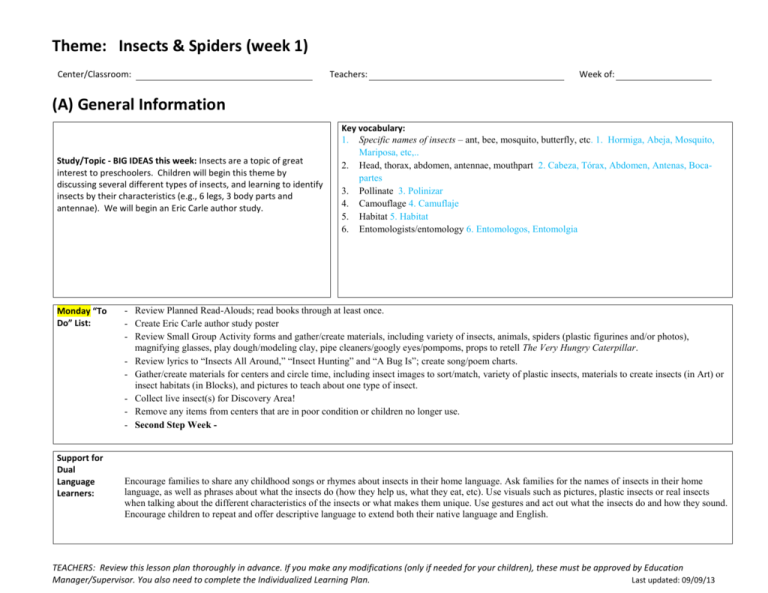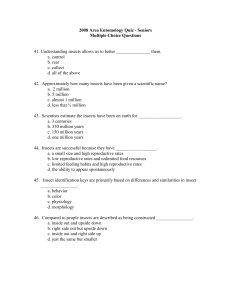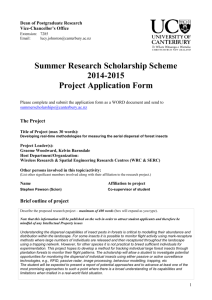
Theme: Insects & Spiders (week 1)
Center/Classroom:
Teachers:
Week of:
(A) General Information
Study/Topic - BIG IDEAS this week: Insects are a topic of great
interest to preschoolers. Children will begin this theme by
discussing several different types of insects, and learning to identify
insects by their characteristics (e.g., 6 legs, 3 body parts and
antennae). We will begin an Eric Carle author study.
Monday “To
Do” List:
Support for
Dual
Language
Learners:
Key vocabulary:
1. Specific names of insects – ant, bee, mosquito, butterfly, etc. 1. Hormiga, Abeja, Mosquito,
Mariposa, etc,..
2. Head, thorax, abdomen, antennae, mouthpart 2. Cabeza, Tórax, Abdomen, Antenas, Bocapartes
3. Pollinate 3. Polinizar
4. Camouflage 4. Camuflaje
5. Habitat 5. Habitat
6. Entomologists/entomology 6. Entomologos, Entomolgia
- Review Planned Read-Alouds; read books through at least once.
- Create Eric Carle author study poster
- Review Small Group Activity forms and gather/create materials, including variety of insects, animals, spiders (plastic figurines and/or photos),
magnifying glasses, play dough/modeling clay, pipe cleaners/googly eyes/pompoms, props to retell The Very Hungry Caterpillar.
- Review lyrics to “Insects All Around,” “Insect Hunting” and “A Bug Is”; create song/poem charts.
- Gather/create materials for centers and circle time, including insect images to sort/match, variety of plastic insects, materials to create insects (in Art) or
insect habitats (in Blocks), and pictures to teach about one type of insect.
- Collect live insect(s) for Discovery Area!
- Remove any items from centers that are in poor condition or children no longer use.
- Second Step Week -
Encourage families to share any childhood songs or rhymes about insects in their home language. Ask families for the names of insects in their home
language, as well as phrases about what the insects do (how they help us, what they eat, etc). Use visuals such as pictures, plastic insects or real insects
when talking about the different characteristics of the insects or what makes them unique. Use gestures and act out what the insects do and how they sound.
Encourage children to repeat and offer descriptive language to extend both their native language and English.
TEACHERS: Review this lesson plan thoroughly in advance. If you make any modifications (only if needed for your children), these must be approved by Education
Manager/Supervisor. You also need to complete the Individualized Learning Plan.
Last updated: 09/09/13
Family/
Community
Involvement:
Encourage families to go on nature walks to look for insects and possible insect habitats. Encourage them to use magnifying glasses, bug catchers or
simply their eyes! Ask families to bring in pictures of insects or insect habitats that they and their preschoolers may come across. Encourage them to talk
about the unique characteristics of different insects and why they do or do not like certain ones. They may even find it interesting to conduct a survey with
their preschooler to find out which insects their other family members like the best or the least!
There are always props and materials needed for classroom activities, and parents can be extremely helpful by donating or lending items. This week items
include collage materials (such as wrapping paper, tissue paper, buttons, cotton balls, etc.), paper towel rolls, branches, rocks – and even live insects (if
they happen to find some!) in appropriate viewing containers with air holes.
(B) Materials to Enhance Children’s Play
Blocks
Dramatic Play
Add: Variety of plastic insects and materials to create
insect habitats: branches, rocks, paper towel rolls,
artificial flowers, etc.
Suggestion: Hang pictures of insects (labeled) on the
walls for children to swat or pretend to catch.
Add:
Plastic insects; jars for collecting insects; butterfly
nets, fly swatters; magnifying glasses; insect
costumes (wings, antennae headband).
Be sure to review and clearly define how to use the
nets and fly swatters safely!
Suggestion: Hang pictures of insects (labeled) on
the walls for children to swat or pretend to catch.
Art
Library/Writing
Add:
Materials to create insects: paper, scissors, paints,
popsicle sticks, paper towel rolls cut in half, pipe
cleaners, pompoms
Pictures of butterflies and other insects (for inspiration)
Add:
Read-aloud books for this week; other insect books
or Eric Carle books
Eric Carle Author Study Poster
Props for retelling The Very Hungry Caterpillar
Sand and Water
Music and Movement
Add:
Encourage children to make ant hills. Include insects
and bug collecting containers
Toys and Games
Add:
Insect images to sort/match
(www.childcareland.com)
Discovery/Science
Add:
Bug catcher, magnifying glass
Picture/chart of lifecycle of butterfly
Pictures of insects
Live crickets, ant farm or caterpillars (if possible)
Computers
Add:
Outdoors
Cooking
© 2012 Acelero, Inc. All Rights Reserved. Uses are subject to the limitations set forth in your user agreement. Your right to use these materials is contingent upon remaining a current
SARGE subscriber with Acelero, Inc.
“Simon Says” (Embedded Assessment for SRG (20) – Physical)
“Insect observations”: Pick a small section of soil, grass or pavement and mark this area with chalk, rocks,
popsicle sticks, or string. Have children observe this area for insects and count how many they see. What are
the insects doing? Where are they going? What do ants do when you draw a line of chalk in their path?
(C) Group Experiences
Monday
Arrival
Opening
Circle
Movement
Relaxation
Transitions
Closing
Circle
Tuesday
Wednesday
Thursday
Friday
Arrival: Attendance graph
Arrival: Attendance graph
Arrival: Attendance graph
Arrival: Attendance graph
Morning Circle:
Welcome song & one other
Morning Circle:
Welcome song & one other
Morning Circle:
Welcome song & one other
Morning Circle:
Welcome song & one other
SS Puppet Script
Begin the KWL chart by
asking children “What do
we know about insects?”
(E.g., can you name any
specific types of insects?
What do you like/ not like
about them?) Time
permitting, also list
anything children want to
know about insects.
QOTD: Where do you
think is the best place for us
to find insects?
(Playground / kitchen /
bathroom – or substitute
other choices that make
sense for your location)
QOTD: “Have you ever
held an insect in your
hand?” (Yes/ No) Talk
about what it felt like or
what they think it would
feel like
Review daily schedule and
rules now and throughout
the day
Transition: QOTD: “Which
of these insects do you like
best?” (ant, bee, butterfly –
or other choices if desired)
have visuals, have children
charting with whiteboard/
pocket chart/etc.
Music/Movement: SS Song
& “Insects All Around”
Improvise a tune or sing to
the tune of "Twinkle, Twinkle,
Little Star" Lady bugs and
butterflies,
Buzzing bees up in the sky.
Teeny, tiny little ants,
Crawling up and down the
plants
Many insects can be found
In the sky and on the ground
Review daily schedule and
rules now and throughout
the day
SS Story and Discussion
Transition: SS Brain
BuilderMusic/Movement: Moving
Like Insects (see below) &
one other
Review daily schedule and
rules now and throughout
the day
Review daily schedule and
rules now and throughout
the day
Transition:
Transition: SS Brain
Builder-
Music/Movement: “Insect
Hunting.”
Music/Movement: SS Song
& one other
A-hunting we will go
A -hunting we will go
We'll catch a (insert any insect
here)
and put it in a box
(loudly) and then we'll let it go!
Relaxation:
& one other movement
song
Relaxation:
Transition: SS Skill ActivityClosing Circle:
Goodbye song
Relaxation:
© 2012 Acelero, Inc. All Rights Reserved. Uses are subject to the limitations set forth in your user agreement. Your right to use these materials is contingent upon remaining a current
SARGE subscriber with Acelero, Inc.
Monday
Tuesday
Relaxation:
Wednesday
Transition: Mighty Minute
#17 Leaping Sounds
Transition:
Closing Circle:
Review QOTD with the full
group, counting each
column and writing the
numeral; then discuss
results (what do you notice?
which answer has the most?
etc.).
Closing Circle:
Goodbye song
Thursday
Friday
Transition: Move like a
winged or wingless insect
to the next activity
Closing Circle:
Goodbye song
Goodbye song
Group 1: Farfallina and
Marcel
ReadAlouds
Group 2: Bugs are Insects
by Anne Rockwell or
similar book
Group 1: Play dough
Insects
SmallGroup
Activity
Special
Activities
Group 2: Insect/ Not Insect
Tangible
Acknowledgement System:
Group 1: Bugs are Insects
by Anne Rockwell or
similar book
Group 2: Farfallina and
Marcel
Group 1: Insect/ Not Insect
Group 2: Play dough
Insects
Group 1: SS BookGroup 2: The Very Hungry
Caterpillar by Eric Carle or
The Very Quiet Cricket
Group 1: The Very Hungry
Caterpillar by Eric Carle or
The Very Quiet Cricket
Group 2: SS Book-
Group 1: SS Skill-Practice
ActivityGroup 2: The Very
Hungry Caterpillar
retelling
Group 1: The Very
Hungry Caterpillar
retelling
Group 2: SS Skill-Practice
Activity-
Play variety of music (fast,
then slow) and encourage
children to move like
different insects. For
© 2012 Acelero, Inc. All Rights Reserved. Uses are subject to the limitations set forth in your user agreement. Your right to use these materials is contingent upon remaining a current
SARGE subscriber with Acelero, Inc.
Monday
Outside
Inclement Weather Plan:
Tuesday
Simon Says (see activity
guide)
Wednesday
example, children could be
buzzing bees pollinating
flowers; ants marching with
food; butterflies emerging
from their cocoons; etc.
Simon Says (see activity
guide)
Thursday
Simon Says (see activity
guide)
Friday
Simon Says (see activity
guide)
Individual Child Planning Form
© 2012 Acelero, Inc. All Rights Reserved. Uses are subject to the limitations set forth in your user agreement. Your right to use these materials is contingent upon remaining a current
SARGE subscriber with Acelero, Inc.
School Readiness Goal
Focus Domain(s)
Physical
Approaches to
Learning
Language &
Literacy
Cogn./ Gen.
Knowledge
Name
Soc-Emotional
Focus
Date
Child’s
Week of:
Strategy/Activity
Focus TS
GOLD
Objective(s)
Why Chosen?
(IFSP, TS Gold Report,
family input, conference
goal, etc.)
NOTE: Children with similar needs may benefit from
differentiated instruction (e.g. during small-group activity).
You can use the “Small Group” column at right to make notes
about possible groupings.
Example: 1. Routine – activity, state how you are
individualizing for this child.
CHECK when
implemented
Teachers:
Possible small-group?
Center/Classroom:
1.
Tuesday
2.
2.
1.
Tuesday
2.
3.
1.
2.
3.
1.
2.
3.
1.
2.
3.
1.
2.
© 2012 Acelero, Inc. All Rights Reserved. Uses are subject to the limitations set forth in your user agreement. Your right to use these materials is contingent upon remaining a current
SARGE subscriber with Acelero, Inc.
3.
1.
2.
3.
IFSP Child Planning
Child’s Name
IFSP Goals
Classroom Plan: What’s the Activity/Who’s Supporting the Child
*Please review all IFSP plans including Speech Only to ensure implementation of all classroom goals.
*For speech goals the what/who would be: Directed by the Speech Language Therapist
© 2012 Acelero, Inc. All Rights Reserved. Uses are subject to the limitations set forth in your user agreement. Your right to use these materials is contingent upon remaining a current
SARGE subscriber with Acelero, Inc.







